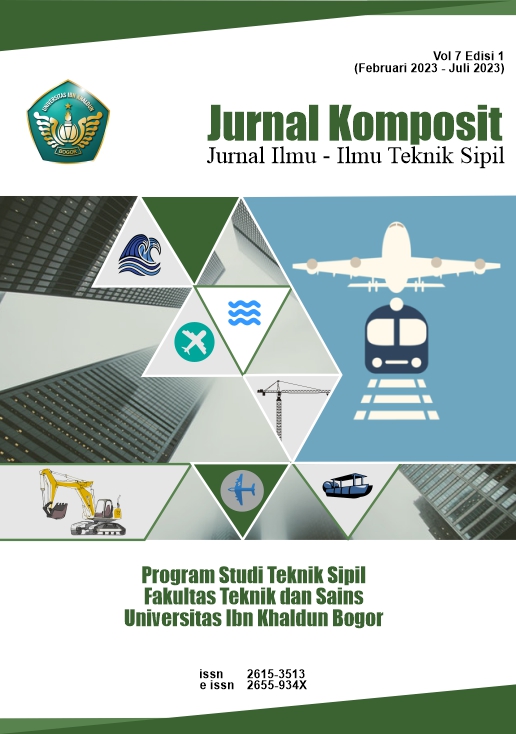Multi-Criteria Analysis Method For Determining The Priority of Bridge Construction
DOI:
https://doi.org/10.32832/komposit.v7i1.9011Abstract
Bridge is one of the important infrastructure facilities which functioned to connect roads that support the development of social and economic in a region. In Indonesia, each year, the limited fund is available to accommodate all construction projects. In practice, the government of Aceh Besar District has limited District Revenue and Expenditure Budgets (APBK) to finance the entire project of bridge construction. Considering that many other sectors still require APBK funding, the priority rank of the bridge development needs to be determined. This study aims to identify the dominant criteria in determining the development of bridges and the priority rank of bridge development projects. This study used a mixed method approach which is a qualitative and quantitative method. The Qualitative method is related to respondent perception through distributing questionnaires and the qualitative method is related to numbers used through the perception score of respondents from the analysis. Respondents are stakeholders and policymakers as many as 8 people. The questionnaire contains some criteria, namely the length of the bridge, construction costs, land use, accessibility, population, and regional development. Based on the literature review, those criteria can be used to obtain which bridge needs to be prioritized. Multi-Criteria Analysis is used to analyze those criteria from respondent perception. The results show that the dominant criteria in determining the construction of bridges in the project were construction costs with a weight of 0.35. It is also obtained that the bridge development project at first rank is the Kr. Keumeuruek with a value of 7.56.
References
Asrul, & Azis, S. (2018). Pengantar Sistem dan Perencanaan Transportasi. Deeplubish.
Usulan DAK Tahun 2020 Bidang Jalan dan Jembatan Kabupaten Aceh Besar, (2020).
Faqih, A. (2016). Pengembangan Wilayah, Teori dan Aplikasi. Kencana.
Direktorat Jenderal Perimbangan Keuangan, Pub. L. No. Nomor 33 (2020).
KK, D. J. P. K. (2020). Rincian Dana Alokasi Khusus (DAK) Fisik Tahun Anggaran 2020 Menurut Provinsi/Kabupaten/Kota.
Mahi, A. (2016). Pengembangan Wilayah, Teori dan Aplikasi. Kencana.
Putra, F. (2012). Governance Inteligence and Quotient. UB Press.
Saaty, T. L. (1994). The Analytical Hierarchy Process: Decision Making in Economic, Political, Social, and Technological Environments. University Pitssburg.
Badan Pusat Statistik (2019). Kawasan Perikanan Kabupaten Aceh Besar.
Sudradjat, H., Djakfar, L., & Yulvi, Z. (2016). Penentuan Prioritas Penanganan Jembatan pada Jaringan Jalan Provinsi Jawa Timur (Wilayah UPT Surabaya). Jurnal Rekayasa Sipil, 9(3).
Sugiyono. (2015). Statistik Non Parametris Untuk Penelitian. Alfabeta.
Tamin, O. (2008). Perencanaan dan Pemodelan Transportasi. ITB.
Thantawi, T., Isya, M., & Sugiarto, S. (2020). Prioritas Penanganan Jalan Kapupaten Pidie Menggunakan Metode Analisis Multi Kriteria (AMK). Jurnal Arsip Rekayasa Sipil Dan Perencanaan, 3(4), 257–267. https://doi.org/10.24815/jarsp.v3i4.16716
Zainuddin. (2010). Struktur Jembatan. Unigoro.
Downloads
Published
How to Cite
Issue
Section
License
Copyright (c) 2023 Jurnal Komposit: Jurnal Ilmu-ilmu Teknik Sipil

This work is licensed under a Creative Commons Attribution-NonCommercial-ShareAlike 4.0 International License.
Authors who publish with this journal agree to the following terms (Penulis yang mengajukan publikasi artikel telah menyetujui hal berikut):
- Through this publication, the author agree to submit the copyright of article writing to Jurnal Komposit: Jurnal Ilmu-ilmu Teknik Sipil. This copyright submission takes the form of, but is not limited to: reproduction of the article and parts therein, including photographic reproductions; distribution of articles through printed and electronic documents; and translation of articles(Bahwa melalui publikasi ini, hak cipta penulisan artikel diserahkan kepada Jurnal Komposit: Jurnal Ilmu-ilmu Teknik Sipil. Penyerahan hak cipta ini berupa, namun tidak terbatas pada: perbanyakan artikel dan bagian di dalamnya, termasuk reproduksi fotografi; penyebarluasan artikel melalui dokumen cetak dan elektronik; serta penterjemahan artikel).
- The authors agree to the terms of the Copyright Notice, according to Creative Commons Attribution-NonCommercial-ShareAlike 4.0 International License., which will apply to this article if and when it is published by Jurnal Komposit: Jurnal Ilmu-ilmu Teknik Sipil. (Para penulis setuju dengan ketentuan Pemberitahuan Hak Cipta, sesuai dengan Lisensi Internasional Creative Commons Attribution-NonCommercial-ShareAlike 4.0., yang akan berlaku untuk artikel ini jika dan ketika diterbitkan oleh Jurnal Komposit: Jurnal Ilmu-ilmu Teknik Sipil).

This work is licensed under a Creative Commons Attribution-NonCommercial-ShareAlike 4.0 International License.



.png)










